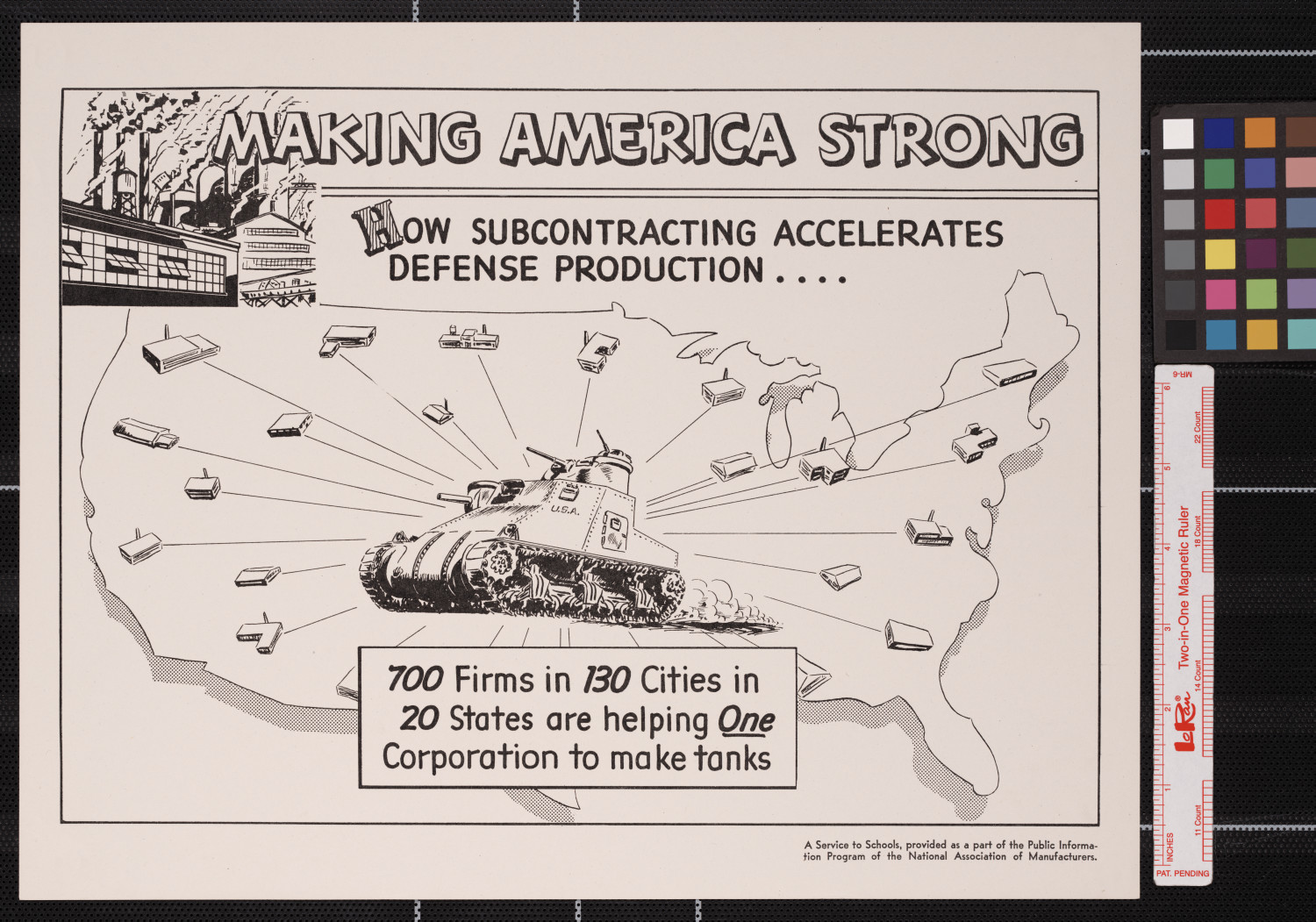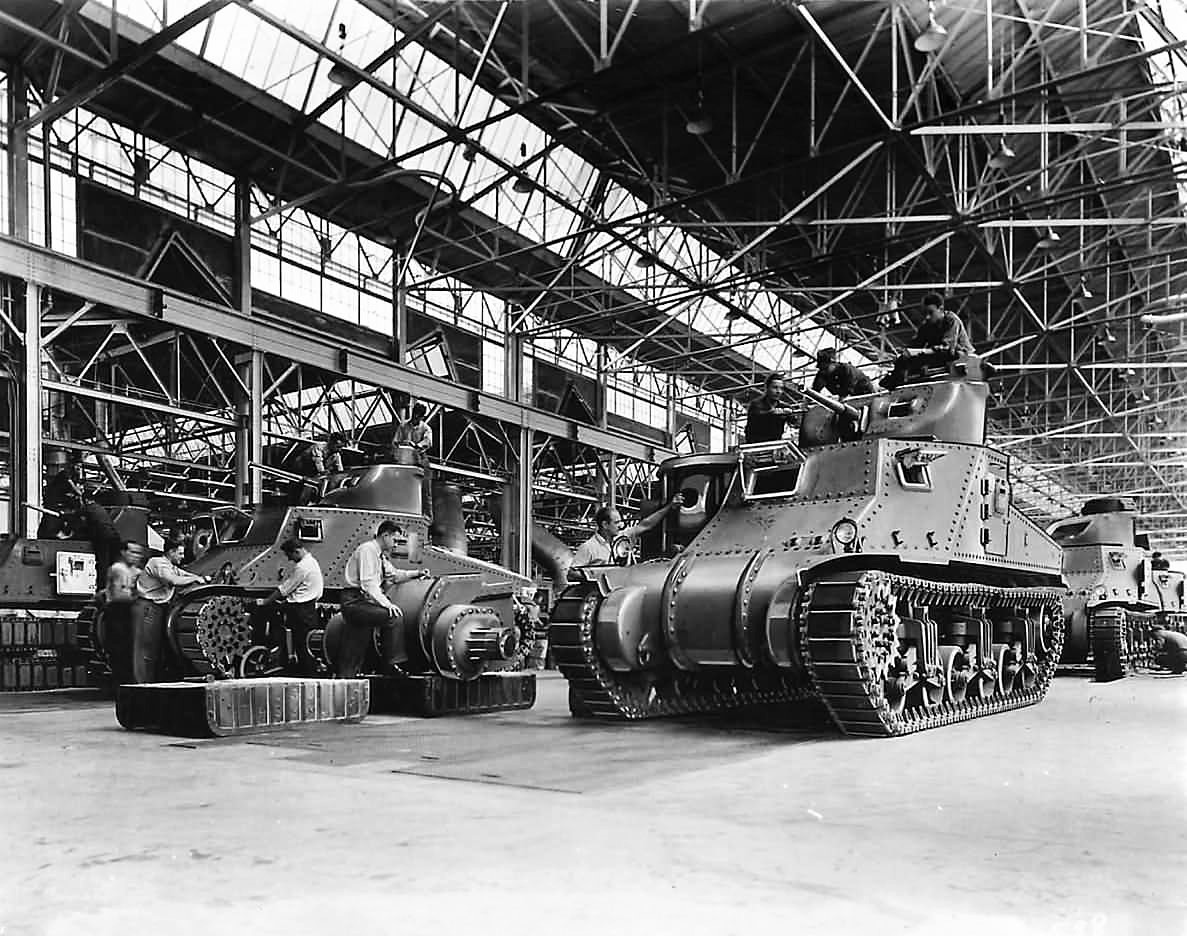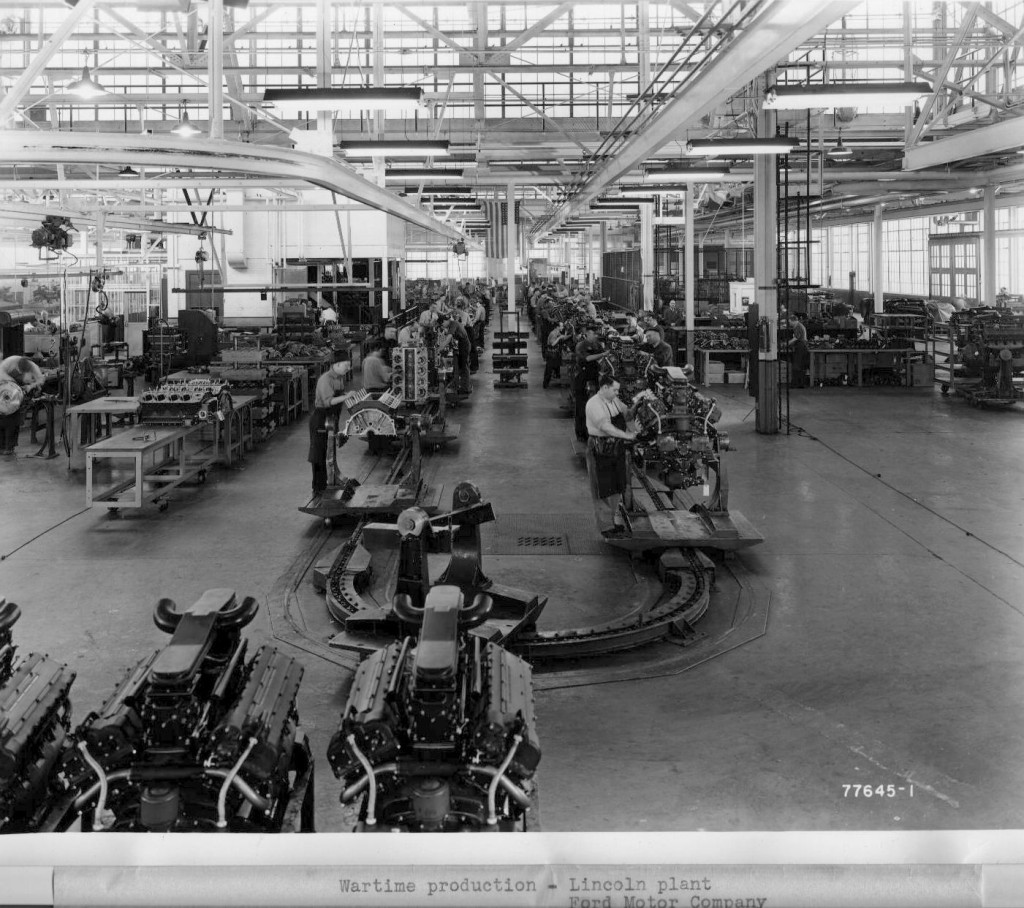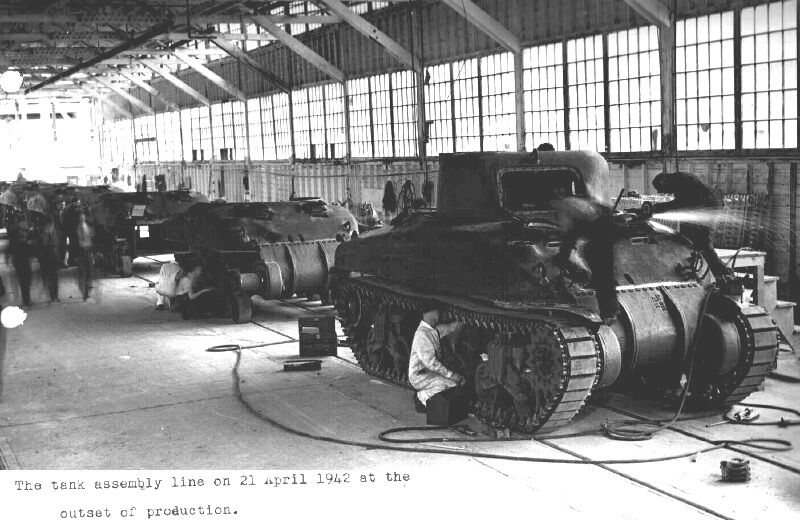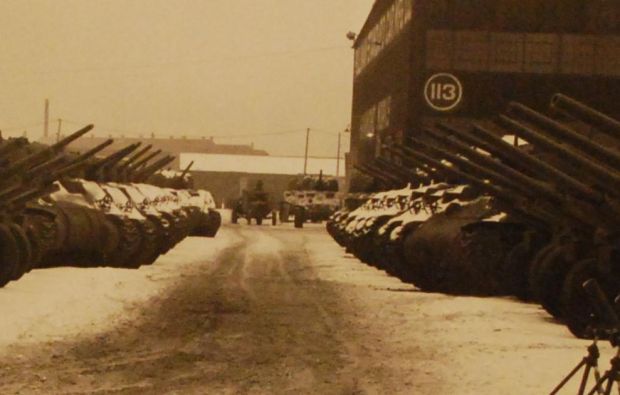Sherman Builders: Just How Many Tank Factories Did the US Have Anyway? There were 10 and 1 in Canada.
Most of the information in this section will be a summation of the section of Son of a Sherman. Other stuff I had to dig around on the internet for. Anyone who has more info on the tank makers, please feel free to contact me. Parts from all these tank makers would interchange. Many used the same subcontractors. I don’t think anyone has tried or if it’s even possible to track down all the sub-contractors who contributed parts to the Sherman at this point. Some of the manufacturers were more successful than others, some only producing a fraction of the total Sherman production, others producing large percentages. By the end of production, all the US and her allies needs for Shermans were being handled by just three of these factories.
American Locomotive (ALCO)
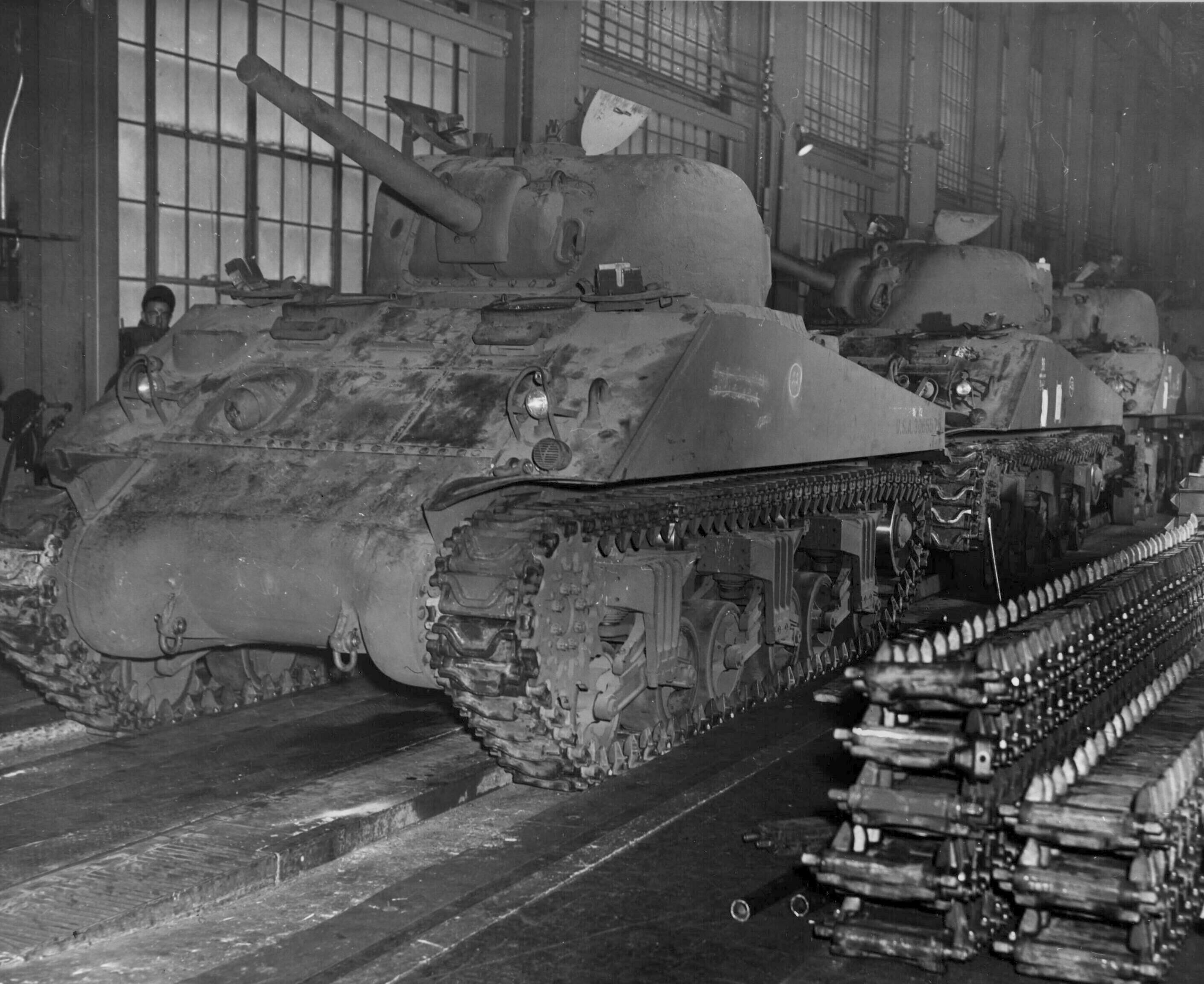
ALCO also produced M3 and M3A1 Lees and made Shermans up to 1943. They were a fairly successful pre-war locomotive manufacturer founded in 1901 in Schenectady, New York. They also owned Montreal Locomotive Works. ALCO made several version of the Sherman, and stayed in the tank game until the late 50s, helping with M47 and M48 production. The company went under in 1969.
American Locomotive produced 2300 Shermans in two models, the M4 (75) and M4A2 (75).
Baldwin Locomotive Works (BLM)

Baldwin was another early producer, building three versions of the Lee, The M3A2, M3A3, and M3A5. They mostly built small hatch M4s all DV tanks, even the ones made in 1944! They made just a handful of M4A2 75 tanks(12). They were out of the Sherman game by 1944 and out of business by 72. They were founded in Philly in 1825 and produced 70,000 steam locomotives before they died.
BLM produced 1245 Sherman tanks in two variants, the M4 (75) and the M4A2 (75)
Chrysler Defense Arsenal (CDA)
Chrysler Defense Arsenal was special. It was a purpose-built tank factory, funded and owned by the US Government, and managed and built by Chrysler, the first of its type and a wild success. William Knudsen, who before taking a job helping get war production going, had been the head of General Motors, called up the president of Chrysler, K.T. Keller, and asked him if he could build tanks for the Army. They came up with the idea of the Tank Arsenal and the Army agreed to fund building it, and pay for all the tooling needed, at a cost of 21 million 1940 dollars, roughly 356 million in today’s money. All the Contracts were signed by 15 August 1940.
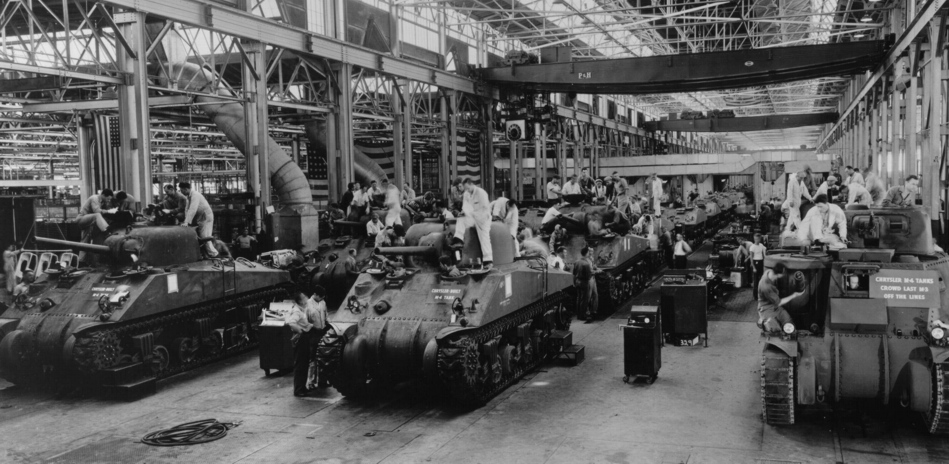
Keller hired a famous architect, who had worked extensively with the auto industry, named Albert Kahn, to design the factory. Chrysler chose Warren Township, just north of Detroit, because the land was abundant and cheap. They bought up 113 acres of farmland, and there were cows around the factory as it was constructed. Construction started as soon as they had final plans for the layout of the Arsenal site, so the ground prep could start. The buildings would have to house 1000 machine tools and over 8000 specialized jigs. When finished, the factory building was five city blocks long, and two wide and would employ nearly 5500 people! They made making Sherman tanks so efficient, they were able to give the US Government 50 Million dollars, 1940s dollars in refunds and price reductions.
Construction on the factory started in September of 1940, and construction continued right through the Michigan winter, even when the site turned into a swamp of mud, until it got cold enough to snow and freeze, and even then work went on. The factory went to work, even and it was being built, and a cadre if under 400 built the first tanks, these M3 Lee tanks were rolling of the line by April of 1941. This was before the factory was even finished being built. It was built to stand up to aerial bombing, because when it was built, the Nazis had everyone on their heels, and no one had any idea how far they would get. They produced M4A4, and M4 tanks as well and M4 105s, M4A3(105)s, and M4A3 76 tank and nearly 18,000 of them. Chrysler was the sole producer of M4A3E8 76 w Shermans, or the tank commonly known and the Easy 8. They produced 2617 units, but post-war many A3 76 tanks were converted over to HVSS suspension. A very big chunk of the overall Sherman production came from this factory and it went on to produce M26 Pershing tanks.
Chrysler used its many other facilities in the Detroit area as sub manufacturers, and many of their sub-contractors got involved too. CDA not only produced the tanks, it had the capacity to pump out huge numbers of spare parts. Chrysler sub-contracted out the suspension component to their Dodge Division. De Soto produced parts for the Shermans gun recoil mechanism. Another subcontractor was Ford since they produced the GAA engines that went into the M4A3 tanks CDA produced.
CDA lived into the 1990s before Chrysler defense systems got sold off to General Dynamics. It took part in making the M26, M46, M47, M48, M60 and M1 tanks.CDA and Chrysler were not just involved in producing tanks, but in making experimental tanks and motors. Chrysler came up with their own water-cooled V12 called the A-65 that was very promising, producing 650 horsepower while only being slightly larger than the A57 setup.
CDA produced 17,947 Sherman tanks, in six variants, The M4A4 (75), M4 Composite, M4A6, M4A3 (76) w, M4A3 (105), and the M4 (105). This was the first defense arsenal completed in the United States, and the one built by GM’s Fisher would be modeled on CDA. It was a popular stop for war bond sales tours, celebrities, and politicians, particularly early on when they seemed to be able to come up with production miracles, keeping up with ever-increasing orders! Chrysler got so good at producing Shermans and lowering per unit costs, they wrote checks back to the government for millions of dollars since they were coming in cheaper than projected. That is unheard of in today’s defense production!
Chrysler Tank Arsenal Plant Brochure: I nice little pamphlet put together by Chrysler to show off their tank production prowess, and unlike today, Detroit, and the US Auto industry had a lot to be proud of. (Big thanks to Chris R for the brochure)
Federal Machine & Welder (FMW)
I couldn’t find much out about FMW, Son of a Sherman says they were founded in Warren Ohio in 1917. They produced less than a thousand M4A2 small hatch tanks. They were slow to produce them, making about 50 a month. They were not contracted to make any more Shermans after their first 540 total, 1942 contract. They did build some M7 and M32 tank retrievers. They were out of business by the mid-fifties.
FMW produced 540 Sherman tanks, all M4A2 (75) models. Not all U.S. factories were miracle stories like Chrysler, and this one is clearly a company that didn’t do all that well. One contract slowly filled got them dropped, and probably would have even if production had not been cut back for other reasons. Another would be the factory built for the M7 medium tank, by International Harvester, which produced 7 tanks before being closed down. Not because of a problem with the factory, in this case, it was the tank no one wanted.
Fisher Tank Arsenal (FTA)
Fisher Tanks Arsenal (FTA) has a lot of common with Chrysler Defense Arsenal, except this time Uncle Sam went to Fisher Body, a division of General Motors. Fisher decided to build the tank plant in Grand Blanc, south of Flint Michigan. The factory broke ground in November of 1941 and the first M4A2 Sherman rolled off the line in January of 1942 before the factory was fully built. Unlike Chrysler, they didn’t have to start from scratch and could use CDA as an example of what to do.
The M4A2 was something of this factory specialty, in particular early on, with them producing a large number of the small hatch M4A2 sent off to Russia, and a few of the rarer large hatch 75mm gun tanks, around 986 small hatch tanks, and about 286 large hatch tanks.
They also produced nearly 1600 large hatch, 76mm gun tanks, or the M4A2 (76)w. These tanks went almost exclusively to Russia as part of Lend Lease. These tanks were ordered over four different contracts and the final ones off the production line were all HVSS tanks. The HVSS suspension may have seen combat with the Russians before the US Army used it. Oddly, this factory also produced M4A3 76w tanks, but never with the HVSS suspension. Fisher produced a significant number M4A3 and Large hatch 75mm tanks at their factory, but nowhere near their M4A2 production.
Fisher was a division of General Motors and leading up to WWII, GM was a huge company, producing other Sherman parts in other divisions as well. Buick produced the M1 series of 76mm guns for all the vehicles that used them. They also produced transmissions and final drives use on the Sherman and M10 GMC, and 3-inch shells for the M7 Gun. They also made He and AP shells for the M3 75mm gun. They made more than 45 million shells of various types during the war! Harrison Radiators were used in Shermans. Oldsmobile also produced canons, the 75mm M3, and also the 76mm M1 series, and many others. They also produced ammunition for these guns as well. The AC Sparkplug Division produced Sherman instrument panels. The Delco-Remy division produced started and generators, and voltage regulators. Detroit Diesel division produced the motors for M4A2, and M10 tanks, and the diesel Lees. Inland Division had a lot to do with Sherman Tracks, producing several types of tracks and the pins that held them together. Moraine Products Division produced engine bearings for all GM 6046 powered Shermans and TDs. The New Departure Division produced ball bearings for the Sherman, used in the turret ring. The Packard Electric Division produced a lot of the actual electric wires used in the Sherman tanks. Pontiac Motor Division produced the connecting rods, cylinder liners and flywheel housings used in the GM 6046 twin diesel. The Saginaw Malleable Iron Division produced the T49 trackpads from steel castings. They also improved production speed on the M2 .50 Machine gun, and the M1919, by casting in steel parts that had been forged in the past requiring more time to produce. Saginaw Steering Gear Division produced a lot of M1919A4 machine guns, some surely made it into Shermans. United Motors Service Division ran the Lima Tank Depot in Lima Ohio. This depot was used to prep all the tanks shipped to the ETO and MTO. Shermans from all the makers would pass through this depot. These depots, there was a west coast one in Richmond California, run by Ford. These Depots were not just storage yards, they prepped the tank for use overseas, making sure it was fully operational, and up to date. This would mean installing M34A1 gun mounts and all the quick fix modifications, which added armor around the sponson racks, and removal of the ready rounds around the base of the turret etc. They then boxed up everything that couldn’t fit inside, sealed the tank up and put it on a train.
GM was a production powerhouse, for more info check out this really interesting website. The American Auto Industry in WWII. I cannot say how much I like this site, but it is tremendous, you could spend hours reading subpages here, and he has a lot of very nice, photos he took himself along with a large number of Company War books. The US Auto Industry has a lot to be proud of for what they accomplished during the war.
FTA Produced 11,358 Sherman tanks in six versions, The M4A2 (75), M4A2 (75), M4A3 (75)W, M4A2 (76)W, M4A3 (76)W, and the M4A3E2. Note: All M4A3 tanks produced by Fisher had Ford built GAA motors.
Ford Motor Company (FMC)
Ford was a surprisingly small player in the Sherman tale. They are very important in that they developed the Ford GAA V8 covered earlier, and a lot of spare parts. But they only produced 1690 small hatch Shermans between June of 42 and Oct 43. They built 1038 M10A1s as well. All these tanks and tank destroyers were produced at their Highland Park facility. After 1943, they stopped building tanks, and wouldn’t get back into until the 50s, and even then it was just for a large production run over a short time, of M48s. Don’t get the idea Ford didn’t contribute to the war effort, they built their own modern production miracle in the B-24 bomber plant. They did produce almost 30 thousand Ford GAA motor, that would be used by CDA and FTA when they built M4A3 tanks.
Lima Locomotive Works (LLW)
Lima was one of the first producers of the cast hull M4A1. It did not produce any Lee tanks. Its production capacity had been taken by locomotives to the point just before Sherman production started. They produced the first production M4A1, that was shipped to England, named ‘Michael’, and it’s still on display at the Bovington Museum. They produced Shermans from February of 42 to September of 1943, producing M4A1s exclusively, and they built 1655 tanks. The war was a boon for Lima, they’d been in business since 1870, and the contracts from the military for locomotives really helped them out. Postwar, they failed to successfully convert to diesel-electric locomotives and merged with another firm.
Montreal Locomotive Works (MCW)
MLW was owned by American Locomotive. They produced some wacky Canadian tank based off the Lee chassis, called the Ram, and Ram II, these floppy creations were only armed with a 2 pounder in the Rams case, and a 6 pounder, in the Ram IIs case, and they produced almost 2000 of the wacky things, what’s that all aboot? They eventually got around to producing a proper Sherman tank, the M4A1 “Grizzly”, producing only about 188 tanks. A very few had an all metal track system that required a different sprocket. Other than that, there was no difference between a grizzly and an M4A1 manufactured by any other Sherman builder. Don’t believe the Canadian propaganda about it having thicker armor!
Pacific Car & Foundry (PCF)
PCF was founded in 1905 in Bellevue, Washington. After they bought out there only real competitor in the early 20s, they were the only heavy machinery company and foundry in the Pacific Northwest. They were the go-to foundry for steel used in the building of many Seattle landmarks. In 1924 the founder, William Pigott sold a controlling interest in the company to American Car and Foundry Company. In most stories about a company, it would end right there, but in a twist of fate, the Son of William Pigott, Paul Pigott, bought back a controlling share of the company in 1934.
At first, the company seemed to do ok during the great depression, but it was really on the ropes until just before WWII, when the increase in military spending helped them out. Their steel and aluminum were used in the B17, numerous Naval vessels, and tanks. They were also one of the Sherman tank producers that could produce its own gun mounts and produced enough other Sherman factories used them.
The only west coast tank maker, PCF produced 926 M4A1s from May of 1942 to November of 1943. The foundry had the facilities to produce all the big castings, the M4A1 Sherman used, in-house. As soon as production stopped they started production on the M26 tractor, the truck portion of the M26 tank transporter, also known as the Dragon Wagon. They never got back into tank production again, but they did produce one very special tank destroyer. The almost mythical T28 super heavy tank and the army managed to lose one.
The Shermans they produced were used by units training up and down the west coast, and many were sent to the Pacific. Company A, of the 1st Marine tank battalion, received a 24 of PCF’s M4A1 Shermans, the only ones the Marines would use. These PCF Shermans have a few things that make them easier to identify, the easiest to see is the dust cover mount around the hull machine gun, PCF’s is distinct and made from a strip of steel instead of a rod. Many of these Shermans were produced with the T49 steel tracks. These tanks would see combat in the swamps and jungles of Cape Gloucester. A battle I will cover in detail later.
The T28, also known as the T95 105mm gun motor carriage, two of these massive vehicles were made, and PCF made both. They came in at 100 just under 100 tons and were designed to get a very powerful 105mm gun close enough to knock out heavy fortifications, like the type along the Siegfried line. It was also considered for use in the Invasion of Japan had that been necessary, and man, think of the weird porn the Japanese would come up with if we had invaded with a bunch of these bad boys, instead of nuking them. It had a set of double wide HVSS suspension on each side, with four bogie groups, and armor up to a foot thick. It had a four-man crew and used the same 500 horsepower Ford GAA V8 to move it. Yes, 100 tons, 500HP, a real hot rod that thing was. Development ceased after the war, and any kind of testing on the two prototypes stopped by 47. One prototype burned out, and was scrapped; the other just disappeared for several decades and was found in a remote spot on Fort Belvoir in Virginia. It is now stored in an army parking lot, not open to the public, rusting away.
Pacific Car & Foundry still exist today as PACCAR Inc., one of the largest truck makers in the world. They own both Kenworth and Peterbilt. They also produced much of the steel structure on the Twin towers of the World Trade Center. They built the PACCAR tower in Bellevue in in the late 60s and it’s still their HQ today. They are worth 18,8 billion as of 2013.
Pressed Steel Car (PST)
PSC was one of the big boys of Sherman production, and they also produced the final M4s made, a group of 30 M4A1 76 HVSS tanks. PSC was founded in Pittsburg in 1899, but their tank factory was in Joliet, Illinois. They were the second manufacturer to make the tank and across all the versions they made, they produced 8147 Sherman tanks.
They started tank production with the M3 Lee in June of 41, and stopped production on that in August of 1942. They then produced the M4A1 from March of 42, to December of 43, and the standard M4 from October of 42 to August of 43.
They were one of the final three tank makers to stay in the tank making business after 1943, along with CDA and FTA. PSC would produce large hatch M4A1 76 tanks, including HVSS models late in the run, totaling more than 3400 M4A1 tanks. They produced 21, M4A2 76 HVSS tanks, towards the end of 45.
They were out of business by 56, with no tank production after those final 30 M4A1 76 HVSS tanks. PST produced a total of 8147 Shermans tanks in four types, M4 (75), M4A1 (75), M4A1 (76)W, and the M4A2 (76)W.
Pullman Standard (PSCC)
Pullman Standard was a pretty famous luxury train passenger car maker and another company that made rolling stock combined into one company. Pullman Palace Car Co was founded in 1867, or thereabouts. I’m sure some train geek will be dying to fill me in on the company’s history but I’m not really going to look deeply into it. It does make for one of the more interesting stories about a Sherman tank producer. Their main tank factory was in Butler, Pennsylvania. And they helped produce some Grant tanks before they started Sherman production.
They produced the M4A2 from April of 42 to September of 43 and produced 2737 tanks. They also produced 689 standard M4 Sherman tanks from May of 43 to September of 43. Soon after these contracts were finished the US Government broke the company up due to some anti-trust complaint.
PSCC produced a total of 3426 Sherman tanks, in two types, the M4 (75), and the M4A2(75).
♠♠♠
The thing to remember about all the Sherman makers is each one had a small imprint on the tanks they produced. So an M4A1 small hatch tank was the same no matter who made it and all parts would interchange with no modification needed, but the tanks from different makers still had small, cosmetic differences. They may have been something like nonstandard hinges on the rear engine doors to the use of built-up antenna mounts instead of cast. Or wide drivers hoods or narrow, to where the lift rings on the hull were and how they were made or even Chryslers unique drive sprocket they put on all their post A4 tanks. None of this meant the parts couldn’t be salvaged and used on another Sherman from another factory without much trouble. Some factories may have produced tanks faster than others, but they all produced them within the specification of the contract or they were not accepted.
The ability to interchange parts between factories was a pretty big deal, and it wasn’t just the tank factories that did it. All US manufacturing that had war contracts with the government had specifications to meet. These specifications were tight enough to require a well-designed system of mass production. This meant that not only were the tanks, aircraft, trucks, weapons, and ships, etc., built faster but were of higher quality as well. The US Aircraft industry is another beautiful example of this, producing 100,000 fighters, and with interchangeable parts, so a Boeing B-17 built at the Vega plant, could take and install any part made at the Boeing plant, or Douglas plant, or any of the many subcontractors. This was not even peak production, and in many cases production was held back, not by factory capacities, but by who the War Production Board decided got raw materials.
This is something The Nazi regime could only dream of, their industry was still simple production lines using skilled and unskilled labor with very little to no automation. This did help them hide it from bombers; since it could be moved around more readily, but that’s just about the only plus side to the way Nazi Germany did things. When you add in slave labor, well, you get a picture that doesn’t seem to match the stories about the wonderful German tanks and their ace tankers saving Europe from the commie. It’s probably because that story was mostly Nazi propaganda anyway.
